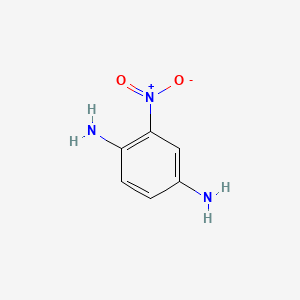D0681 | 2-nitro-1,4-phenylenediamine
| Toxicity | Dose | Time | Species | Model | Method | Action | Positive criterion | Reference |
|---|---|---|---|---|---|---|---|---|
| MEMBRANE POTENTIAL | 7.07±6.53 | human | qHTS-HepG2 | MMP assay | decrease | IC50 | 163 | |
| MEMBRANE POTENTIAL | 12.59 | human | HepG2 | MMP assay | decrease | IC50 | 163 | |
| MEMBRANE POTENTIAL | 18.06±14.95 | rat | hepatocytes | MMP assay | decrease | IC50 | 163 | |
| Pictogram | Signal | Statements | Precautionary Statement Codes |
|---|---|---|---|
 |
Warning |
Aggregated GHS information provided by 74 companies from 9 notifications to the ECHA C&L Inventory. Each notification may be associated with multiple companies. Reported as not meeting GHS hazard criteria by 1 of 74 companies. For more detailed information, please visit ECHA C&L website Of the 8 notification(s) provided by 73 of 74 companies with hazard statement code(s): H315 (17.81%): Causes skin irritation [Warning Skin corrosion/irritation] H317 (93.15%): May cause an allergic skin reaction [Warning Sensitization, Skin] H319 (17.81%): Causes serious eye irritation [Warning Serious eye damage/eye irritation] H335 (16.44%): May cause respiratory irritation [Warning Specific target organ toxicity, single exposure Respiratory tract irritation] Information may vary between notifications depending on impurities, additives, and other factors. The percentage value in parenthesis indicates the notified classification ratio from companies that provide hazard codes. Only hazard codes with percentage values above 10% are shown. |
P261, P264, P271, P272, P280, P302+P352, P304+P340, P305+P351+P338, P312, P321, P332+P313, P333+P313, P337+P313, P362, P363, P403+P233, P405, and P501; (The corresponding statement to each P-code can be found at the GHS Classification page.) |
 |
Warning |
H302: Harmful if swallowed [Warning Acute toxicity, oral] H317: May cause an allergic skin reaction [Warning Sensitization, Skin] |
P261, P264, P270, P272, P280, P301+P312, P302+P352, P321, P330, P333+P313, P363, and P501; (The corresponding statement to each P-code can be found at the GHS Classification page.) |
| 1,4-Benzenediamine, 2-nitro- | 1,4-Diamino-2-nitrobe | 1,4-Diamino-2-nitrobenzene |
| 1,4-Diaminonitrobenzol | 1,4-Diaminonitrobenzol [German] | 2,5-Diaminonitrobenzene |
| 2-N-p-PDA | 2-NDB | 2-NITRO-P-PHENYLENEDIAMINE |
| 2-NITRO-p-PHENYLENE- DIAMINE | 2-NPPD | 2-Nitro-1,4-benzenediamine |
| 2-Nitro-1,4-diaminobenzene | 2-Nitro-1,4-phenylenediamine | 2-Nitro-1,4-phenylenediamine, 95% |
| 2-Nitro-1,4-phenylenediamine, technical, >=95.0% (NT); | 2-Nitro-4-aminoaniline | 2-Nitro-4-phenylenediamine |
| 2-Nitro-benzene-1,4-diamine | 2-Nitro-para-phenylenediamine | 2-Nitrol-p-phenylenediamine |
| 2-Nitrol-para-phenylenediamine | 2-nitro-benzene-1,4-diarnine | 2-nitrobenzene-1,4-diamine |
| 2NDB | 3-13-00-00271 (Beilstein Handbook Reference) | 4-Amino-2-nitroaniline |
| 5307-14-2 | 856826-84-1 | AB1008672 |
| AC-11799 | ACMC-1AKVA | ACT07445 |
| AI3-52604 | AK-47270 | AKOS000120413 |
| AM20060657 | ANW-31629 | BP-12513 |
| BR-47270 | BRN 2210195 | C.I. 76070 |
| C.I. Oxidation Base 22 | C19385 | CAS-5307-14-2 |
| CCRIS 452 | CHEBI:76394 | CHEMBL353971 |
| CI 76070 | CI Oxidation Base 22 | CS-W018077 |
| CTK1G9462 | D0105 | DB-052251 |
| DSSTox_CID_957 | DSSTox_GSID_20957 | DSSTox_RID_75885 |
| DTXSID4020957 | Durafur Brown | Durafur Brown 2R |
| Dye GS | EBD48864 | EINECS 226-164-5 |
| F0001-1368 | FT-0606833 | Fouramine 2R |
| Fourrine 36 | Fourrine Brown 2R | HSDB 4098 |
| HVHNMNGARPCGGD-UHFFFAOYSA-N | KS-00000JGK | KSC269I6F |
| LS-190 | MCULE-9496576017 | MFCD00007903 |
| MP-2159 | NCGC00091278-01 | NCGC00091278-02 |
| NCGC00091278-03 | NCGC00091278-04 | NCI-C02222 |
| NSC 5377 | NSC-5377 | NSC5377 |
| Nitro-p-phenylenediamine | Oxidation base 22 | PV83F3C01Q |
| Q26840737 | RTR-018782 | SBB064230 |
| SC-27286 | SCHEMBL78083 | ST24022361 |
| ST51040055 | STR08741 | TR-018782 |
| Tox21_400026 | UNII-PV83F3C01Q | Ursol Brown RR |
| VZ25045 | W-105773 | ZINC3860651 |
| Zoba Brown RR | du rafur brown | o-Nitro-p-phenylenediamine |
| p-Phenylenediamine, 2-nitro- |

